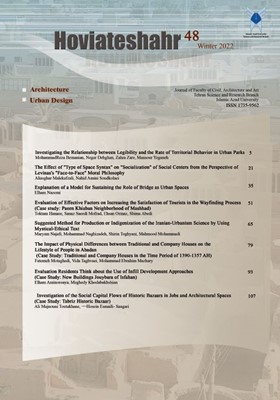Investigating the Relationship between Legibility and the Rate of Territorial Behavior in Urban Parks
Subject Areas : architectureMansour Yeganeh 1 * , Negar Dehgan 2 , Zahra Zare 3 , Mansour Yeganeh 4
1 - Professor, Art and Architecture Faculty, Tarbiat Modares University
2 - M.A. in Landscape Architecture, Tarbiat Modares University, Tehran. Iran
3 - M.A. in Landscape Architecture, Tarbiat Modares University, Tehran, Iran.
4 - Associate Professor of Architecture, Architectural Design, Modeling, and fabrication Lab, Tarbiat Modares University, Tehran, Iran
Keywords: Social interactions, Territory, Territorial behavior, Behaviorism, Legibility,
Abstract :
Landscape design involves functional as well as perceptive and imaginative aspects of space. It is this particular combination, which is essential to making contemporary landscapes more attractive. Legibility is a quality of the environment that clarifies the city and makes the city's image better remembered. In urban parks, the components of spatial legibility can create different degrees of territorial behavior in citizens. According to Lynch's theory, these components include the legibility of paths, nodes, districts, edges, and landmarks. Therefore, the impact of urban parks legibility on several users and reaching a territorial behavior in these spaces formed the present study's focus. Territory refers to the part of urban spaces that individuals or groups regularly and consistently benefit from and protect against intruders and outsiders because of their sense of belonging and ownership of the area.Any personalization and marking in the environment or defense against harassment is considered a form of territorial behavior. Territorial behavior is one of the social dimensions of urban spaces. The quality and way of its occurrence are related to the quality of urban public spaces. In other words, citizens' attitudes and levels of territorial behaviors interact with the criteria by which they evaluate an urban public space as favorable, with high quality. Strengthening territories in parks create an environment that will give users a sense of belonging and ultimately lead to increased social interactions in the urban environment. The purpose of this research is to study the process of the impact of legibility and how to apply methods to improve territorial behavior in urban parks. This research used a descriptive-analytical research method, followed by a survey to serve the empirical research aspect. The paper claims that the proper path widths, recognizable entrances, distinguished districts, and the ease of comprehension of the space are useful and considered by the citizens to be very desirable and necessary to create legibility. Also, having different people in a park and being comfortable and flexible is one of the most vital factors in enhancing the sense of ownership and defensiveness of a place. To enhance territoriality and understand the space, it is necessary to consider the criteria by which citizens evaluate legibility because of differing the legibility assessment criteria in diverse parks. The design of spaces should also consider the citizens' diversity and cultural differences and create spaces appropriate to the people who use that place, following the social and cultural context. The results show that legibility indicators must exist together in one space to make that space understandable from citizens' viewpoint. Moreover, this understanding will ultimately enhance the sense of ownership and territory. Physical legibility is analyzed through variables such as geometry, spatial structure and configuration, visual barriers and disruptions, access capabilities, underlying architectural components of routing and path recognition, node, edge, district, landmark or landscape, and quantitative and syntactic legibility. Compared to related research, the innovation aspect Conceptual modeling and extraction of readability mechanisms and processes (factors on components) in urban parks are other unique aspects of the study.
_||_

